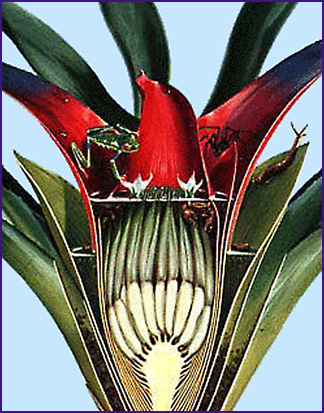

original painting by: William H. Bond
as published in National Geographic 1975 147(3):393
used with permission of National Geographic
Sponsored by:
The University of Florida
Department of Entomology & Nematology
Gainesville, Florida
Visit our home page
Phytotelmata are structures formed by non-aquatic plants that impound water, such as modified leaves, leaf axils, flowers, stem holes or depressions, open fruits and fallen leaves. The word was coined by Varga (1928) [Biologisches Zentralblatt 48: 143-162] and has been adopted into English (see Maguire 1970 and Fish 1983). The singular is phytotelma (or phytotelm), and plural is phytotelmata (or phytotelms).
Popular (i.e., non-technical) reviews of one or more aspects of bromeliad phytotelmata have been written by Bates (1968), Beutelspacher (1971) in Spanish, Butler (1974), Cutak (1953), Diesel (1991) about crabs in Jamaica, Foster (1956), Frank (1990a,b, 1994) about mosquitoes in Florida, Hoehne (1951), Janetzky & Vareschi (1993), Leme (1993), Krügel (1992), McWilliams (1969) about crabs, Picado (1912) in French, Méndez (1983) about crabs, Read (1969), Reitz (1983) in Portuguese, about mosquitoes in southern Brazil, Rivero (1984, 1989) about frogs in Puerto Rico and Venezuela, Scott (1914), Smith (1941), and Zahl (1975). The best illustrations are provided by Leme (1993) and Zahl (1975). A rather more technical review which describes the ecological conditions governing life in bromeliad phytotelmata is provided by Frank (1983): it emphasizes mosquitoes but does not ignore other organisms.
A bibliography of the aquatic biota in bromeliad phytotelmata
The references for the abovementioned articles are given in this bibliography. Most of the items cited in the bibliography were, however, written by and for professional biologists, and may be thought to be dull and technical by non-biologists. Antecedents of the bibliography are in Fish & Beaver (1978), Frank (1983) and Krügel (1993). The bibliography is copyrighted, but it may be used freely for educational purposes (not for commercial profit) if cited as follows: Frank, J.H. 1996. A bibliography of the aquatic biota in bromeliad phytotelmata. Published on the WWW at http://BromeliadBiota.ifas.ufl.edu/fitbib.htm.
The following links hasten access to last names of authors:
A list of the aquatic biota in bromeliad phytotelmata
A classified list of aquatic organisms ranging from algae, fungi, bacteria and protozoa through insects to frogs was provided by Frank (1983) but is now outdated and incomplete. It will be expanded and made available here as soon as possible.
This is an update to the text of a publication by Frank (1994). It will later be expanded to include new information. This work should be cited as: Frank, J.H. 1996. Bromeliad-inhabiting mosquitoes in Florida. Published on the WWW at http://BromeliadBiota.ifas.ufl.edu/mosbrom.htm.
This is an account of the Brachyura (crabs), Ostracoda (seed shrimps), Cladocera (water fleas) and Copepoda (copepods) that have been found in the water in bromeliad leaf axils and bromeliad tanks. It should be cited as: Janetzky, W. 1997. Crustacea in bromeliad phytotelmata. Published on the WWW at http://BromeliadBiota.ifas.ufl.edu/crbrom.htm.
This is an account of the Rotifera (rotifers, or wheel animalcules) that have been found in the water in bromeliad leaf axils and bromeliad tanks. It should be cited as: Janetzky, W.J., Koste, W. 1997. Rotifera in bromeliad phytotelmata. Published on the WWW at http://BromeliadBiota.ifas.ufl.edu/robrom.htm
Last updated 01/28/2020